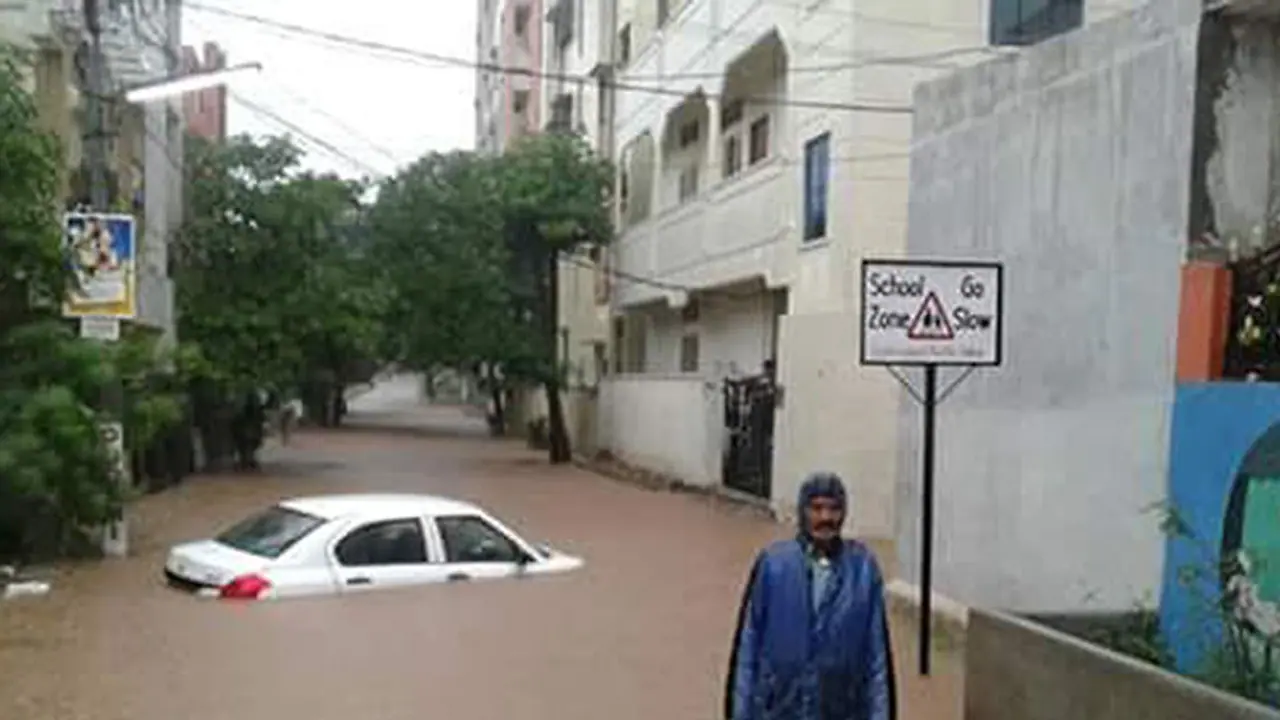The last time Hyderabad saw the Hussainsagar lake filled to the brim was in the year 2000 when the city was flooded after over two days of continuous rainfall.

Today the pictures of a waterlogged Tank Bund road, that abuts the iconic lake, brought back those memories.
Fortunately, for the city, the tap in the sky was turned off after 11am, bringing some calm and sense of normalcy to Hyderabad. But around 71 mm of rainfall was enough to convert much of Hyderabad into a swimming pool.
Municipal officials say the city's drains are built only to take about 20mm/hour of rainfall while it rained close to 70mm/hour between 7 am and 11am.
Realising driving on Hyderabad's roads was fraught with risk - what with the municipal body's tendency to leave some manholes open and potholes aplenty - a tense municipal commissioner even asked office goers to postpone getting behind the wheel by an hour.
But SOS calls had started coming in by then. Hyderabad witnessed tragedy in Bholakpur area where a mother and her two toddlers were buried under rubble. In another locality in Ramanthapur, a wall collapse killed a migrant family of four from Mahbubnagar.
The Hussainsagar lake is always the best indicator of a good monsoon. By noon, thanks to the inflows from some nallahs, it had touched its danger mark of 513.41 metres. It necessitated opening the sluice gates, for the first time in 16 years. A canal was also created for water to be let out of the lake after warning people in low lying areas downstream of Hussainsagar to be alert.
“Is Hyderabad going the Chennai way?'' was a refrain heard since morning, with pictures of submerged vehicles appearing on mainstream and social media.
The biggest problem, like in Chennai and Bengaluru, is the rampant construction and encroachments in lake beds. So it is but natural that when it rains heavily, these ‘saucers' get filled up because that is the natural gradient for the water. Durgam Cheruvu, the secret lake in Cyberabad, for instance, has colonies approved all around it and the area gets submerged with every downpour.
Over the years, the land terrain has changed a lot in Hyderabad and these manmade interventions have played havoc with the manner in which water would flow naturally from one water body into another. Unlike in Bengaluru, where an attempt is being made in the face of public criticism to reclaim the storm water drains, the municipal body in Hyderabad has paid scant attention to this aspect because if it does, it will expose its own building regularisation schemes whereby for a petty penalty, builders have been allowed to get away with violations of all kinds.
The Greater Hyderabad Municipal Corporation says it had identified 1997 dilapidated buildings and went on to demolish 940 of them. But there are still some 900-odd buildings which are still occupied. With the IMD predicting rain over the next 48 hours, the GHMC has asked occupants to move out immediately.
But experts believe this is a kneejerk reaction. “A safety audit needs to be done and this should be done by the National Disaster Response Force. This needs a dedicated task force as the municipal staff is overburdened. The NDRF's database should have this list,'' says Maheep Singh Thapar, town planning expert.
After a dry August, the monsoon has returned to Telangana with a vengeance. Wednesday's downpour is a warning sign to the authorities to get their act together and ensure Hyderabad does not go the Chennai way. For that it needs to urgently engage with experts to do some serious macro level planning, in which integration of water bodies by clearing them of encroachments is given top priority.
